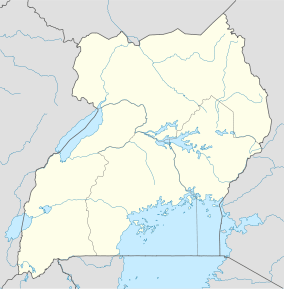Isimba Power Station
| Isimba Power Station | |
|---|---|
 | |
| Location | Isimba, Kamuli District, Uganda |
| Coordinates | 00°49′30″N 33°01′48″E / 0.82500°N 33.03000°ECoordinates: 00°49′30″N 33°01′48″E / 0.82500°N 33.03000°E |
| Status | Under construction[1] |
| Commission date | 2018 (Expected) |
| Power station | |
| Primary fuel | Hydropower |
| Power generation | |
| Maximum capacity | 183 MW |
Isimba Power Station is a 183.2 MW hydroelectric power project under construction in Uganda. [2][3]
Location
The Power Station is located at the village of Isimba, on the Victoria Nile, in Kamuli District.[4] This location lies approximately 40 kilometres (25 mi), downstream of Bujagali Power Station.[5] The approximate coordinates of the power station are:0° 49' 30.00"N, 33° 01' 48.00"E (Latitude:0.8250; Longitude:33.0300). The coordinates are estimates because the power station does not yet appear on most publicly available maps as of July 2013.
Overview
Isimba Power Station is a 183 MW hydroelectric power plant that is under construction across the Victoria Nile, downstream of Bujagali Power Station. The contract for feasibility studies and structure design, worth US$3.8 million was awarded to a consortium consisting of the engineering firms Fichtner and NORPLAN. The local Ugandan company, Kagga & Partners, is a sub-consultant to the consortium. Their report became available in late 2010.[6]
In July 2013, Ugandan print media indicated that the construction contract had been awarded to China International Water and Electric Corporation (CWEC), a Chinese firm. The generation capacity has also been increased to 183.2 Megawatts. Construction began on 6 October 2013 and is expected to last approximately four years.[7][8]
Construction costs
The total project was originally estimated at US$350 million, including the construction of power transmission lines connecting Isimba Power Station to the national power grid at Bujagali Power Station. In 2008, the Uganda Government, secured a loan from the Exim Bank of India to fund the construction.[9] In April 2013, Ugandan print media reported that the Indian government had extended a credit line worth US$415 for the construction of the dam.[10] In July 2013, media reports indicated that the cost of the dam had risen to US$570 million, funded by a loan from the Export-Import Bank of China.[11][12]
External links
- Estimated Location of Isimba Power Station At Google Maps
- Construction Underway As of October 2013
- Construction of Isimba Power Station Expected to Commence Once Bujagali Power Station Is Complete
- Isimba Hydropower Dam Is Second Chinese Power Project In Uganda During 2013
- Chinese Firm To Build Uganda's Isimba Hydro-electric Dam
See also
- List of power stations in Uganda
- List of hydropower stations in Africa
- List of hydroelectric power stations
- Kamuli District
- Kamuli
References
- ↑ Construction Started In 2013
- ↑ Feasibility Studies Carried Out In 2009
- ↑ Isimba Dam Capacity Increased To 188 Megawatts
- ↑ Isimba Is Located In Kamuli District
- ↑ Approximate Distance Between Bujagali Power Station And Isimba Power Station With Map
- ↑ Initial Planned Capacity At Isimba Was 100MW
- ↑ Construction of Isimba Dam Started In October 2013
- ↑ Chinese Firm Begins Work On Isimba Power Station
- ↑ Exim Bank of India Lends Uganda US$350 Million for Isimba
- ↑ India To Lend US$450 For Isimba Power Plant
- ↑ Isimba Dam Construction Estimated At Five Hundred Seventy Million Dollars
- ↑ Chinese To Fund And Build Uganda's Isimba Hydroelectric Dam
| ||||||||||||||||||||||